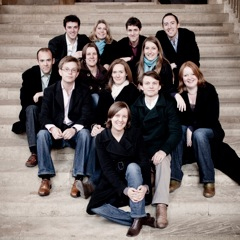by Daniel Hathaway

Most of Stile Antico’s singers — Helen Ashby, Kate Ashby, Rebecca Hickey, Emma Ashby, Eleanor Harries, Katie Schofield, Jim Clements, Andrew Griffiths, Benedict Hymas, Will Dawes, Tom Flint & Matthew O’Donovan — grew up in the choral tradition of the Anglican Church and many still sing professionally in cathedrals and parish churches. The ensemble operates without a conductor or artistic director, making Stile Antico unique among vocal ensembles of its size. The group also boasts three sisters among its members, two of them twins.
Because of travel schedules, a telephone interview proved impossible, but baritone Will Dawes kindly responded to some of our questions by email.
Q. Without the benefit (or liability!) of a conductor, how does the group choose repertory? Make decisions in rehearsal? Audition new members if that becomes necessary?
A. With so much wonderful music from the Renaissance to choose from, it’s difficult to know where to start in choosing new programmes. The nuts and bolts of the process are that there are a few of us who discuss new programmes, and, as a team, we come up with what the structural pieces in the programme will be, and what else to add. Every member of the group is able to suggest pieces!
Making decisions in rehearsal is always going to be a slower process when more than one person is able to make the decisions, and in this sort of music (where there are no wrong answers) there’s so much to decide. However, we never want to rush the process, so we try a variety of approaches to the piece to begin with, and once we start to settle on the overall character and interpretation, the smaller decisions tend to fall into place quite quickly.
When a member of the group leaves, we know that finding the right person is absolutely crucial. It can appear to be a drawn out process: all of the 11 remaining members of the group meet to decide on the long list, then after listening too those candidates, decide altogether on those who we feel we want to offer some time working with the group — they have to be the right fit as much as the right voice. Only several months later will we offer someone the job, and that must be a unanimous decision.
All three points above can be summarised by the fact that all decisions are based on the ethos of democracy — there’s no primus inter pares here!
Q. Most of your singers have grown up and been trained through the great Anglican choral tradition. But there are subtle differences in choral sound from choir to choir. How has the group arrived at its own, distinctive sound, and how would you describe it?
A. We’re hugely lucky in the UK to have the Anglican choral tradition. Most of us have benefitted from a vast amount of high-level choral singing between the age of 18 and 21, but not all of us were cathedral choristers, or choral scholars at Oxbridge. In the many professional choirs in the UK, it’s naturally crucial that each has their own sound. It’s difficult to put an exact finger on ours, but essentially, we try to create sounds of real expression which are in sympathy with the text and character of the piece we’re singing. Judge for yourself when you hear us!
Q. In “Phoenix Rising” you interleave motets between movements of Byrd’s Mass for Five Voices. Interesting, but why?
A. If I had to name two sorts of composition which virtually always have multiple ‘movements’, I’d say a Symphony and a Mass. Whereas the Symphony is meant to be conceived as a whole (and its movements are therefore performed consecutively) music for the ordinary of the Mass would have been interspersed around readings, prayers, communion, and indeed other motets etc, though we’re by no means presenting a liturgical construction! There’ll always be a choice to make in how we present the mass on record and in concerts — either sequentially, or interspersed with other music, and we believe the latter provides a more balanced diet in the context of a concert.
Published on ClevelandClassical.com October 8, 2013
Click here for a printable version of this article.



